Stay in the know on all smart updates of your favorite topics.
Sensemakers Workshop DIY Smart Glasses

During this evening Paul Stefaan Mooij will introduce the DIY Smart Glasses he developed, he is bringing several 'arms'. The PMSG kit lets you swap out those boring old arms from your (sun)glasses for a custom-made PCBA that looks and functions like something a hacker MacGyver would dream up. It fits just like the original—using the same hinges, screws, and probably duct tape somewhere—but now you’ve got space for sensors, connectors, and all the IoT magic you can pack onto your temples.
Join us to experiment, learn and envision new sensors and possibilities.
https://www.hackster.io/psmooij/pmsg-prototype-modular-smart-glasses-8bd4e6
https://github.com/Control-C/PMSG
For more info and rsvp: https://sensemakersams.org/events/
The workshop is from 19-21h in the Makerspace of the OBA and you can also just walk in!
OBA: Oosterdokskade 143, 1011DL Amsterdam
Sensemakers Workshop MeshCore, configure your own node

Join us to learn to understand the concept of MeshCore, an open source, off grid, decentralized, mesh network build to run on affordable low-power devices!
Prepare and configure your own device as to contribute to Amsterdam wide coverage, or just for fun / to chat:-)
The workshop is based on this device: https://nl.aliexpress.com/item/1005007752194012.html Of course you may bring a different device, it only might take a little extra effort on your part if the settings are different. We will try to help of course!
For more info and rsvp: https://sensemakersams.org/events/
The workshop is from 19-21h in the Makerspace of the OBA and you can just walk in!
OBA: Oosterdokskade 143, 1011DL Amsterdam
Sensemakers X-Mas Workshop

For our end-of-the year event we have some extra opportunities to build, create and even program your own souvenir to take home!
Please if you want to make and take home the Xmas lights you see in the picture, the kit costs 25,- (we also have 2 Pay-It-Forward kits). Of course you can also work in other small projects or 3D print a small Xmas tree or make (for children!) a self designed wooden lamps!
You don't have to rsvp via meetup, the workshop is from 19-21h in the Makerspace of the OBA and you can just walk in!
OBA: Oosterdokskade 143 1011DL Amsterdam
Sousveillance: Civic Surveillance of Surveillance Cameras

How can citizens reclaim transparency in a world increasingly shaped by networked safety and enforcement cameras? Join our ThingsCon workshop to explore the power of sousveillance—using the tools of surveillance to scrutinize the systems that watch us.
Networked safety and enforcement cameras increasingly shape urban life, yet their presence and function often remain opaque. This workshop explores how citizens can turn the tools of surveillance back onto the systems that watch them: Redirecting object recognition to identify street camera's for civic scrutiny. Building on several camera spotting tours supported with various versions of a “mobile transparency app”, we introduce a new prototype that uses object recognition to detect street cameras and log them through a civic annotation workflow.
The workshop is for anyone interested in civic tech, democratic oversight, and human-scale alternatives to opaque “smart city” systems. Together, we explore how civic sousveillance might evolve into a deeper practice of scrutinizing—and reshaping—the technologies embedded in our streets.
More info and tickets: https://thingscon.org/events/things-2025
More info on the Human Values for Smarter Cities research project we are conducting: https://humanvaluesforsmartercities.nl/
Workshop Meshtastic, configure your own node (for Amsterdam-wide coverage)

Join us to learn to understand the concept of Meshtastic, an open source, off grid, decentralized, mesh network build to run on affordable low-power devices!
Prepare and configure your own device as to contribute to Amsterdam wide coverage, or just for fun / to chat:-)
It starts at 19h in the OBA in the Makerspace on level minus 1 (Junior department). You can rsvp via meetup or by sending an email to sensemakersams@protonmail.com. But our meetings are open to all so feel also free to just walk in.
https://www.meetup.com/sensemakersams/events/305263631/
How to maintain good intentions in the smart city?

During this ThingsCon Salon, we explore how to give good intentions a lasting place in smart city projects. Join us!
On October 29th from 16:00-19:00 we will be at the stunning Scheveningen Pier for a workshop and talks on how to give good intentions a lasting place in government digital projects. Sign up here!
What is the Thingscon Salon about?
When you interact with the municipality, you often first encounter a digital tool: a website, a menu system, an algorithm, or a parking scan car. There are important reasons behind such digital systems: they're convenient and often efficient.
But if things go wrong, citizens shouldn't get lost in the digital reality. That's why the municipality promises its residents, for example in a coalition agreement, the human dimension in the digital city. And according to project plans, a digital tool should be fair, accessible, transparent, and just.
These kinds of good intentions are formulated before or at the beginning of development processes, but can sometimes slip out of view along the way. During procurement, development and implementation, choices are made that later seem to clash with the original intentions.
How do we design so that good intentions remain leading not just at the beginning, but also during execution?
During this ThingsCon Salon, we explore how to give good intentions a lasting place in government digital projects. Using one or two case studies, we'll develop concrete methods in a workshop to make intentions tangible and maintain them throughout the entire process – from administrative agenda to technical implementation and practical, daily use.
This Salon is co-organized by the 'Human Values for Smarter Cities' project from the Amsterdam University of Applied Sciences and Smart City The Hague. The program consists of a workshop and several speakers.
Tessa Steenkamp and Mike de Kreek will host the workshop.
Date: Wednesday October 29th
Time: 16:00-19:00
Location: Infopunt Scheveningen
Sensemakers Special on Digital Twins for Safety & How technology facilitates Extremism

This Wednesday we have 2 interesting speakers:
- Technical gamechangers for extremism
Nikki Sterkenburg, Professor Investigative Journalism Studies (VU) on how new technology facilitates and impacts extremism. - Digital Twins for safety during big events
Jan de Wit of the Safety Region walks us through the use of digital twins for safety during major events. A lot of technology was used during the Sail event last summer. Jan explains the chosen approach and the insights gained.
It starts at 19h in the OBA on the 6th floor (Forumzaal). You can rsvp via meetup or by sending an email to sensemakersams@protonmail.com. But our meetings are open to all so feel also free to just walk in.
Uncover the Hidden Tech of Amsterdam’s Streets

Join us on June 25 for the Sensor Discovery Tour, a guided walk through the bustling Leidseplein area — a real-time lab for smart city technologies. As sensors increasingly shape how we move, live, and feel safe, concerned citizens are asking: Who sees what, and why?
Combining the new Transparent City AR app prototype and your own phone we’ll reveal the invisible digital layer of the city — from cameras to air quality sensors — and explore what these devices measure, who owns the data, and how they impact our rights.
This isn’t just a tour — it’s a growing citizen-led movement for digital transparency in public space. Together, we’ll reflect on the ethics, ownership, and social value of urban tech. Led by experts in sensor policy and urban innovation, the tour invites Amsterdammers, technologists, designers, and policymakers to reimagine the smart city as open, visible, and accountable.
🕓 25 June 2025 | 16:00–18:00
📍 Start: Leidseplein | End: De Balie
🎟️ Free – registration required
Digital Society School - Transformation Learning Programme Info session
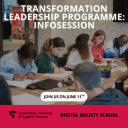
Call to all aspiring leaders!
Are you looking for the next step in advancing your leadership and management skills in alignment with your current role?
Join our upcoming info session on June 11th to learn more about the Transformation Leadership Programme (TLP) – Digital Society School’s part-time programme designed for professionals ready to lead change in the digital and sustainable transition.
We’re looking for Netherlands-based professionals with a Master’s degree and at least 2 years of relevant work experience, particularly with skills in project and team management.
During the info session we will be joined by former Transformation Owners from the TLP track who will share their own experiences during the programme.
The info session will take place online on June 11th 16:00 CET. See you then!
Waag Open: de slimste deurbel

Weet jouw deurbel alles van je buren? Of juist van de privacywetten? Welke deurbel plaatst de grappigste opnames op het internet? Kortom; wie heeft de slimste deurbel?
Een op de vijf huizen in Nederland heeft inmiddels een slimme deurbel, met als populairste deurbellen die van Amazon (Ring), Google (Nest) en het Chinese Anker (Eufy). Maar de slimme deurbel heeft ook een keerzijde; geen van die fabrikanten toont een oprecht initiatief om het ontwerp van hun producten op de Nederlandse privacywetten aan te passen. Ze slaan beelden veel langer op dan het advies van de Autoriteit Persoonsgegevens (AP), laten het nooit merken als ze filmen, hoogstens met een sticker die voorbijgangers op de hoogte zou moeten stellen van actief cameragebruik.
Tijdens Waag Open: De slimste deurbel bespreken we de recente ontwikkelingen rond de slimme deurbellen met ontwerper Roos Groothuizen. Ook ga je aan de slag met je eigen slimme deurbel! Aan welke voorwaarden wil je dat jouw slimme deurbel voldoet? Bouw je een slimme deurbel die helemaal in lijn is met privacywetten? Een deurbel die het buurtgevoel versterkt? Of misschien juist een bel die meteen alle beelden automatisch op internet zet?
Programma
| 19:30 - 19:45 uur | Welkom en intro |
|---|---|
| 19:45 - 21:15 uur | Presentatie Roos Groothuizen |
| 21:15 - 21:30 uur | Smart Deurbel ontwerpen |
| 21:30 - 22:00 uur | Nabespreking en borrel |
Edge AI Handson Special @SensemakersAMS

This Wednesday we'll be tinkering in the Makerspace of the OBA again, you can work on your own projects but you can also join the free workshop where you can learn to run an AI model locally on your smartphone or microcontroller and teach it to do keyword spotting or object recognition.
Looking forward to seeing you! We spreken trouwens ook Nederlands!
Remote Sensing (Satellites), Vrijheidscollege

Dimitri Tokmetzis (1975) is a historian and investigative journalist. He leads the data team of Follow The Money and wrote the books Je hebt wel iets te verbergen (2016) and De digitale Schaduw (2012). He is currently very much involved in remote sensing, which allows you to obtain information about a person, animal or thing without making physical contact. In his Freedom Lecture he discusses power and freedom in a time when the sky is full of satellites.
The intention is to end the evening with an interactive debate based on the lecture!
Send an email to SensemakersAMS@protonmail.com if you want to join!
Sensemakers #IoTDay celebration: Easter Workshop

For the 15th year we're celebrating International IoTDay, it's all about sharing knowledge about how to create your own projects and connecting with people in the process!
We’re excited to share a fun and engaging project with you! Join the Easter workshop, creating a beautiful personalized ornament that you can lasercut and program yourself! (of course we'll help!)
More information on the project can be found here:
https://sensemakersams.org/wp-content/uploads/2024/12/Sensemakers-XMas2024-Project.pdf
There is a fee involved, but we have 2 'Pay-It-Forward' kits available for those low on budget this holiday season. Just dm Manon if you want one of those!
And of course we'll have some free alternatives like experimenting with 3D printing your own Easter-buddy:-)
Speculative Design Workshop - Futuring the City with Generative Things
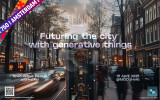
Imagine a world where everyday objects are imbued with the power of generative AI. What possibilities and challenges would emerge? ThingsCon aims to explore this frontier by inviting designers to create provotypes of the near future “generative things”.
To ignite imagination and foster meaningful discussions, we like to use the concept of “provotypes” – provocative prototypes of generative things. These tangible glimpses into tomorrow are catalysts, opening up critical dialogues about our impending relationships with AI-infused objects.
The exhibition “Generative Things” premiered at TH/NGS 2024 on 13 December 2024 in Volkshotel Amsterdam and will travel to other places in 2025, sparking conversations and imagination. ThingsCon organizes this initiative in collaboration with the Master Digital Design of Amsterdam University of Applied Sciences and Waag Futurelab.
15 April. Speculative Design Workshop; An Immersive Future Zine
Connected to Salon, we organize a speculative design workshop where we create a Future Zine that brings the provotypes to life using speculative design methodologies. The outcomes will be used to create immersive experiences with the provotypes that can be presented and discussed with the visitors of the future fest in June.
Preliminary program of the SDW
09:30 Introduction and icebreaker
10:00 Inspirations from the future
10:30 Discuss in groups per provotype possible future scenarios
11:30 Share and sync the different narratives
12:30 lunch
13:30 Create a contribution to the Future Zine
16:30 Share and wrap-up
The Future Zine is proposed as an online publication with immersive capabilities, the framework will be prepared by ThingsCon.
Location
The Speculative Design Workshop will take place Tuesday 15 April at the location of Master Digital Design, Theo Thijssen Huis building, 4th floor, Wibautstraat Amsterdam.
Read more on the backgrounds of the project on the website.
ThingsCon Exhibition and Salon: Provotypes interactions with city and citizens
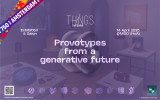
Imagine a world where everyday objects are imbued with the power of generative AI. What possibilities and challenges would emerge? ThingsCon aims to explore this frontier by inviting designers to create provotypes of the near future “generative things”.
To ignite imagination and foster meaningful discussions, we like to use the concept of “provotypes” – provocative prototypes of generative things. These tangible glimpses into tomorrow are catalysts, opening up critical dialogues about our impending relationships with AI-infused objects.
The exhibition “Generative Things” premiered at TH/NGS 2024 on 13 December 2024 in Volkshotel Amsterdam and will travel to other places in 2025, sparking conversations and imagination. ThingsCon organizes this initiative in collaboration with Master Digital Design of Amsterdam University of Applied Sciences, Waag Futurelab, and is part of the Amsterdam 750 futures program.
14 April: exhibition and workshop
Next up, we’re taking Generative Things to Amsterdam University of Applied Sciences. Our next public event, scheduled for late 14 April, will feature:
- An updated exhibition with new and refined provotype designs
- An in-depth reflection workshop relating the provotypes to city life
We’re revisiting the provotypes to create “situated designs” that respond to Amsterdam’s unique context. By partnering with local societal organizations, we’ll develop specific scenarios to test our provotypes in real-world settings, bringing the future of Generative Things to life in our city’s streets and spaces.
The outcomes will be an inspiration and a point of departure for a speculative design workshop on 15 April to create a future zine. We have a separate RSVP for this workshop day.
The program of the Salon:
14:00-15:00 Visit the exhibition with provotypes
15:00-17:00 Workshop to sketch out interactions in the city with each provotype
- introduction on the backgrounds
- short 3 min pitches by designers of the provotypes
- discussing the provotypes in relation to the categories
- formulate takeaways
17:00-19:00 Share results, drinks
If you can not make it to the workshop but like to see the results, feel free to drop by at 17h.
Location
The Salon and the Makeathon will take place Monday 14 April at the location of Master Digital Design, Theo Thijssenhuis building, 4th floor, Wibautstraat Amsterdam.
Read more about the background of the project on the website.
TH/NGS 2024 - Generative Things

Back in November 2014, we organized the first Dutch chapter of ThingsCon in Amsterdam, after the inspiring first Berlin edition in spring 2014. After 4 years in Amsterdam, 4 in Rotterdam en 2 Covid editions, we decided to go back to Amsterdam, and also go back to Volkshotel, to mark our 10 years celebration!
Our theme for this edition: Generative Things
The inspiration for this year’s conference is the transformation of the new generative artificial intelligence in our digital lives to the physical world, the objects we use, and the places we live. What will be the physical realization of the “generative twin intelligence”? What will it mean for makers and designers of these things? How will ethics play out, and what new models of use and trust will emerge?
The program is ready. Check the latest confirmed program here. They are all inspired by this theme.
- Workshops and talks
- Exhibition with the best work
- Specially commissioned exhibition
On the latter:
We want to create an exhibition commissioned by ThingsCon to explore the next decade of living with things. We hope to inspire designers and makers of future things. We like to explain the context of an experience that ignites debate and critical thinking by engaging our community through speculative objects and things.
Our program:
🎓 <strong>Thursday</strong>: long-form workshops for even more in-depth knowledge exchange and interacting with peers.
🎉 <strong>Thursday evening</strong>: celebrating 10 years of ThingsCon with special evening program with inspirational talks, music, and drinks
🎤 <strong>Friday</strong>: the good old mix of inspiring keynotes, short project-pitches, 2-hour workshops, exhibition, and meeting each-other.
This year, the regular price for one day is <strong>100 eu</strong>, and the full conference pass is <strong>175 eu</strong>. The ticket includes entrance and catering on the conference days. You are also invited to join our special Thursday evening program.
Urban AI & Digitalisation

In the new and final Designing Cities For All: RE-generation series City Games in the Age of Urban AI DCFA fellow Ekim Tan, director of Games For Cities and founder of Play The City , explores the role of city games in the era of artificial intelligence. The first episode of City Games in the Age of Urban AI series, Digitalization, with DCFA Fellow Ekim Tan, delves into the dynamic intersection of digitalization, artificial intelligence, and urban games. We will explore how AI is transforming urban environments and the possible effects of AI on digitized and non-digitized communities. How can city games and AI foster deeper connections within increasingly digitized communities and affect collaboration in urban decisions?
Sign up for free now via the link below!
Using AI for All Amsterdammers
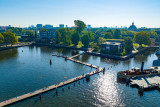
Modern technologies can be used in various ways to make life easier. But if we’re not careful, these possibilities will mainly benefit people who already have it easy. What can technology mean for people who, for one reason or another, have a harder time in society, for example, because they are hard of hearing, have little money, or are immigrants?
The EU project CommuniCity encourages the development of tech solutions for and with various marginalized and/or vulnerable groups. This afternoon, we will present serveral of the pilots that were carried out over the past year, demonstrating how artificial intelligence and other technologies can contribute to the well-being of various residents of Amsterdam.
Sensemakers Special: Embedded systems security and AI & Antifragility; Enterprise Architecture

This Sensemakers evening we have 2 speakers:
Prof. Dr. Lejla Batina from the Digital Security group of the Radboud University will share here insight on the vulnerabilities in the security of embedded systems in the context of AI
and
Edzo Botjes, Antifragility architect and Security coach, will share insights on resilience, chaos, anti-fragile and Enterprise Architecture.
Dataslots
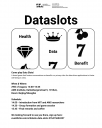
Come play Data Slots!
A board game that fosters conversations on benefits vs. privacy risks for data-driven applications to foster well-being in cities.
When & Where:
29th of August, 14:00-15:45
AMS Institute, Kattenburgerstraat 5, 1018JA,
Room: Beijing/Shanghai
Schedule:
14.00 - Introduction from MIT and AMS researchers
14.30 - Group formation and game session
15.45 - Final remarks and coffee
We looking forward to seeing you there, sign up here:
https://www.eventbrite.com/e/tickets-data-slots-976415604357?aff=oddtdtcreator
Stay up to date
Get notified about new updates, opportunities or events that match your interests.

